- Preliminaries
- IPCC
Reference Model
- Schedule
/ Syllabus
- ITU-T
Reference Model
- Customer
Premises
- Access
Network
- Hierarchy
of Switches
- Signaling
System 7
- Diagram
- Simplified
Graph Theory Analysis
- Generic
VoP/SS7 Softswitch Reference Model
- Model
from Computer Desktop Encyclopedia
- Abstract
Model
- Cisco
SS7/VoIP Softswitch
- Concept:
Cisco Virtual Switch
- Large-Scale
Implementation: Cisco BTS 10200
- Medium-Scale
Implementation: Cisco PGW 2200
- The
Turing Switch
- Diffserv
Model
- Abstract
State Machines
- Viable
System Model
- Using
Recursion to Incorporate TE/NMS in the Model
- Open
Source GNU/Linux Implementation of the Softswitch
Preliminaries
The textbook for
the course is Voice over IP Fundamentals, by Jonathan Davidson and James
Peters (Indianapolis, IN: Cisco Press, 2000). The supplementary texts are:
- Deploying Cisco Voice over IP Solutions, by Jonathan Davidson and
Tina Fox (eds.) (Indianapolis, IN: Cisco Press, 2002). This book is the sequel
to Voice over IP Fundamentals.
- Signaling System #7, 4th ed., by Travis Russell (McGraw-Hill,
2002).
- Signaling System 7 Basics, 3d ed., by Lawrence Harte et al.
(Fuquay-Varina, NC: Althos Publishing, 2003).
IPCC Reference Model
The
reference model for the course is based on the Reference Architecture of the
International Packet Communications Consortium (IPCC) at softswitch.org. The
architecture does not indicate external SS7 components, or functions, that exist
outside the VoP cloud such as the SSP, STP and SCP, but we can fill the gap with
diagrams and text from other sources such as the Desktop Encylopedia at the
computerlanguage.com website.
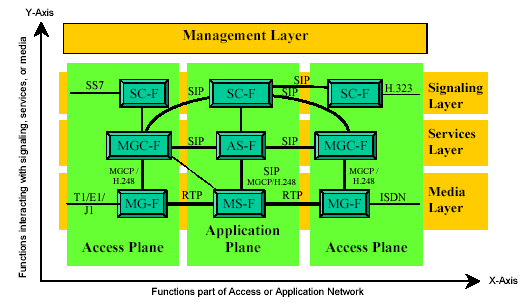
Source:
International Packet Communications Consortium, www.softswitch.org:
Packet
Communications Reference Architecture, V2.0, April 2003, figure 1, p. 4.
Of particular interest in this course is the question, whether the Asterisk
PBX can be extended to include the SS7 access plane (left-hand column of the
reference architecture diagram). We will have more to say about this later.
The application server (AS) is the softswitch component where applications
are executed. The AS also serves as a service creation environment. Typical AS
applications include:
- messaging
- audio conferencing
- video conferencing
- music-on-hold
- web interface
The media server (MS) performs media processing
to fulfill requests by applications in the AS. From this perspective, the AS
commands and the MS carries out those commands. The purpose of the MS is to
serve applications in the AS; in politically incorrect terminology, the
relationship between AS and MS is one of master/slave. Typical MS functionality
includes:
- codecs
- transcoding
- digit detection
- tone generation
- streaming of tones and multimedia announcements
- speech recognition
- speech generation (text-to-speech)
- media mixing
Because of the central role played by the application server and media server
in the softswitch architecture, it will be valuable to analyze the AS/MS in
terms of the Java/J2EE web services model so that we can identify and
distinguish the tiers (client tier, web tier, enterprise / organization tier,
resource tier) and the J2EE-like components within the tiers. In this analysis,
the database icon would be replaced by the media resources that are manipulated
by the MS, but the overall structure is the same:
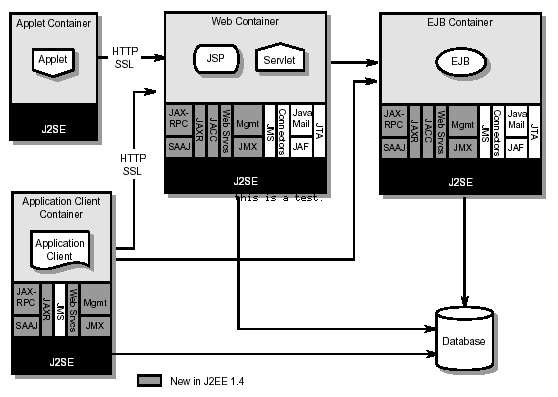
Source:
http://java.sun.com/j2ee/j2ee-1_4-fr-spec.pdf
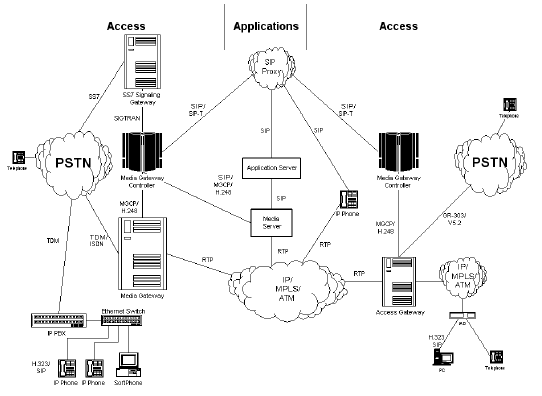
Source: International Packet Communications Consortium,
www.softswitch.org:
Packet
Communications Reference Architecture, V2.0, April 2003, figure 3, p. 10.
Schedule / Syllabus
TBD
ITU-T Reference Model
- Customer premises
- Access network
- Interexchange network
Customer Premises
TBD
Access Network
TBD
Hierarchy of Switches
TBD
Signaling System 7
Diagram
TBD
Simplified Graph Theory
Analysis
An easy way to understand SS7 is as a graph composed of nodes, arcs
and the interfaces that connect the arcs to the nodes.
- Nodes
- SSP: voice/data switches, the meat of the PSTN, it's reason for
being
- STP: routers that direct signaling messages to their destinations
- SCP: databases
- CMSDB
- LNP
- LIDB
- BSDB
- HLR
- VLR
- EIR
- AC
- BC
- SMS
- OSS
- Arcs
- A-link
- B-link
- C-link
- D-link
- E-link
- F-link
- Interfaces
- V.35
- DS0A
- ATM: SONET, DS1, DS3
- RS-232/V.24
- RS-449
Generic VoP/SS7 Softswitch
Reference Model
This model applies not only to voice over IP but also to
voice over Frame Relay, ATM and MPLS (VoFR, VoATM, VoMPLS). Hence the name
VoP: voice over packet. For more information refer to the International
Packet Communications Consortium website at: www.softswitch.org.
Model from Computer Desktop
Encyclopedia
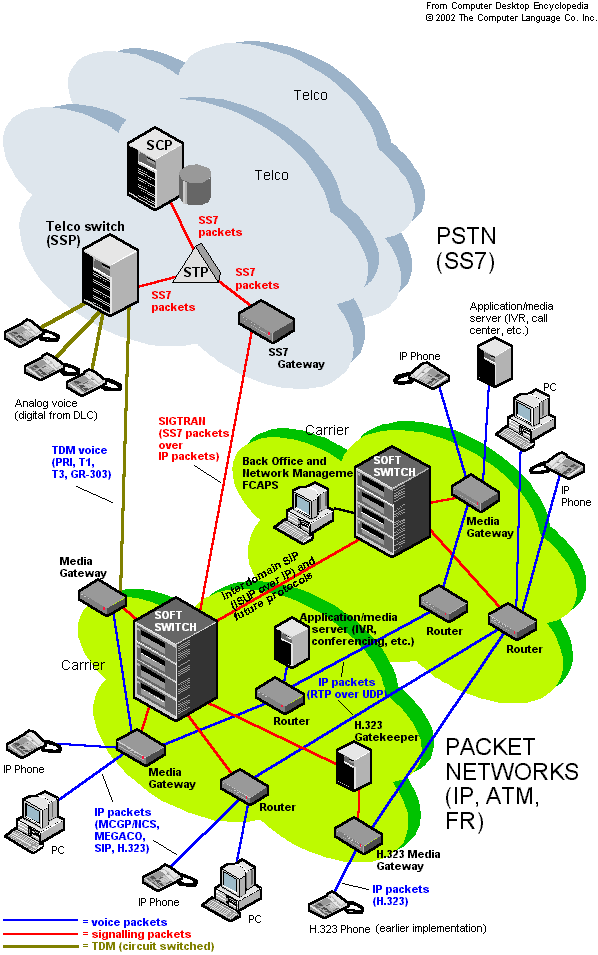
Source: Computer Desktop Encyclopedia at
www.computerlanguage.com.
Abstract Model
TBD
Cisco SS7/VoIP Softswitch
Concept: Cisco Virtual Switch
For a discussion of the virtual
switch (VS) and virtual switch controller (VSC), see chapter 13 of the course
textbook (Voice over IP Fundamentals). Also see the Packet Voice Network
Architecture diagram in the textbook (p. 288, figure 13-2).
Large-Scale Implementation: Cisco BTS 10200
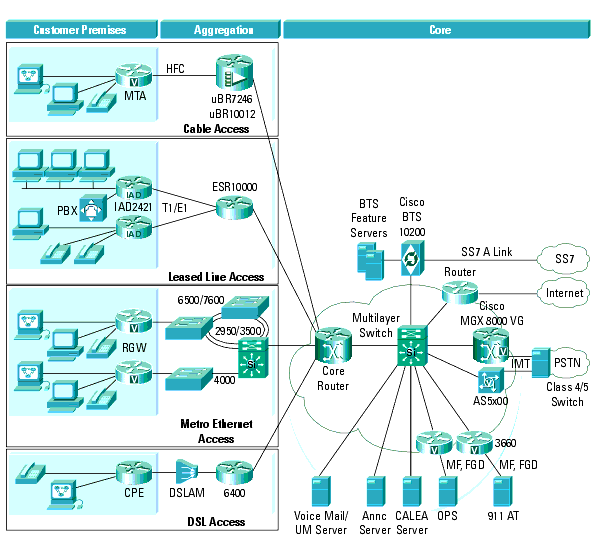
Source:
Cisco BTS 10200 Softswitch Data Sheet, figure 1, Cisco BLISS network
configuration, at:
http://www.cisco.com/en/US/products/hw/vcallcon/ps531/products_data_sheet09186a00800888bf.html
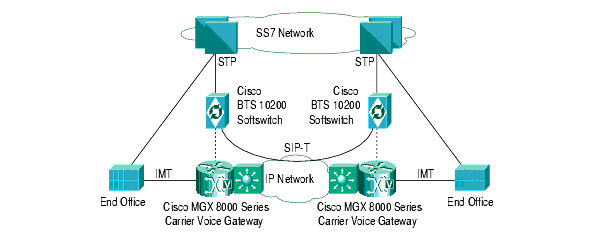
Source: Cisco BTS 10200 Softswitch Data Sheet, figure 2,
Cisco VIA solution network configureation, at:
http://www.cisco.com/en/US/products/hw/vcallcon/ps531/products_data_sheet09186a00800888bf.html
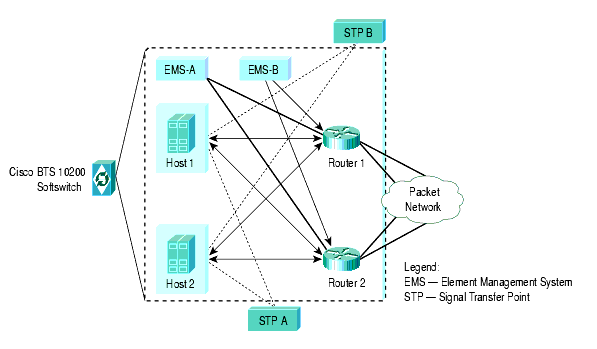
Source: Cisco BTS 10200 Softswitch Data Sheet, figure 5,
Cisco BTS 10200 softswitch components, at:
http://www.cisco.com/en/US/products/hw/vcallcon/ps531/products_data_sheet09186a00800888bf.html

Source: Cisco BTS 10200 Softswitch Data Sheet, figure 6,
Cisco BTS 10200 services and applications, summary diagram,
at:
http://www.cisco.com/en/US/products/hw/vcallcon/ps531/products_data_sheet09186a00800888bf.html
Medium-Scale Implementation: Cisco
PGW 2200
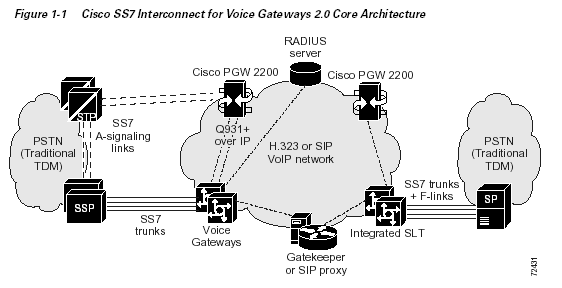
Source: Cisco SS7 Interconnect for Voice Gateways 2.0
Overview at www.cisco.com.
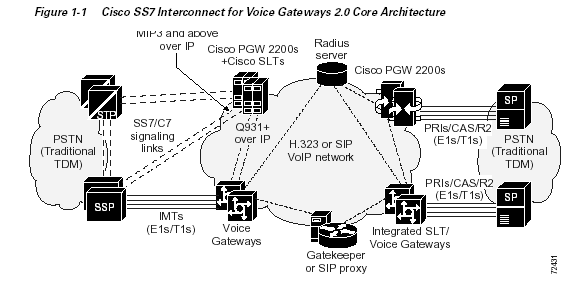
Source: Cisco SS7 Interconnect for Voice Gateways 2.0
Implementation Guide at www.cisco.com.
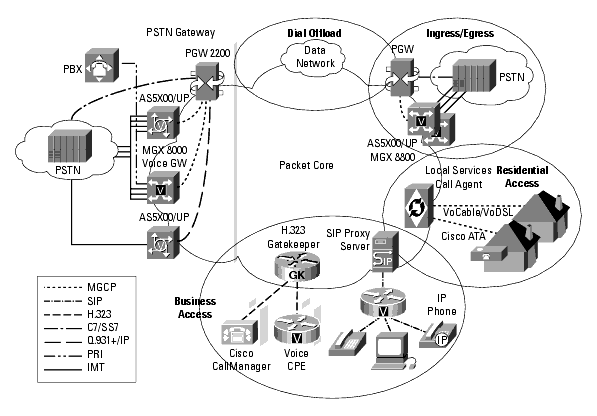
Source: Cisco PGW 2200 PSTN Gateway Data Sheet, figure
1, at
www.cisco.com.
http://www.cisco.com/en/US/products/hw/vcallcon/ps2027/products_data_sheet09186a0080091b59.html
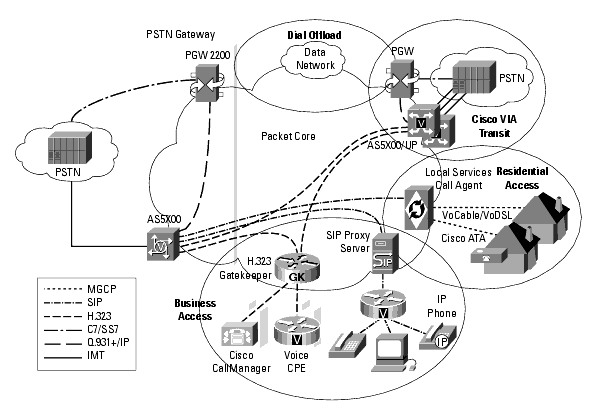
Source: Cisco PGW 2200 PSTN Gateway Data Sheet, figure
2, at
www.cisco.com.
http://www.cisco.com/en/US/products/hw/vcallcon/ps2027/products_data_sheet09186a0080091b59.html
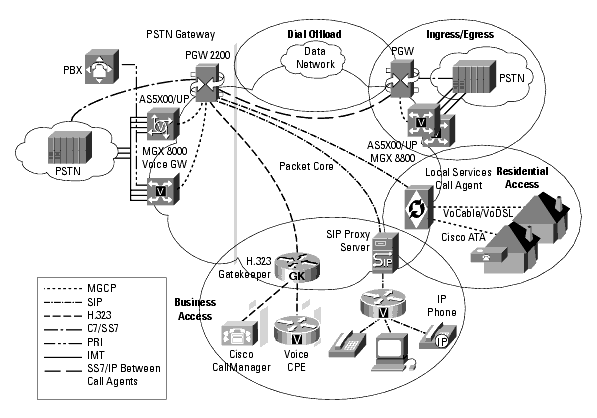
Source: Cisco PGW 2200 PSTN Gateway Data Sheet, figure
3, at
www.cisco.com.
http://www.cisco.com/en/US/products/hw/vcallcon/ps2027/products_data_sheet09186a0080091b59.html
Each PGW 2200 node in the above diagrams has two components:
- Host: Sun Netra server
- Signaling Link Terminal (SLT): Cisco 2600 router
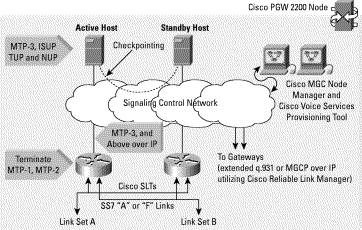
Source:
Cisco Signaling Link Terminal (SLT) Data Sheet, figure 1, at
www.cisco.com.
http://www.cisco.com/en/US/products/hw/vcallcon/ps2152/products_data_sheet09186a0080091b58.html
The Turing Switch
Diffserv Model
TBD
Abstract State Machines
TBD
Viable System Model
TBD
Using Recursion to Incorporate
TE/NMS in the Model
TBD
Open Source GNU/Linux
Implementation of the Softswitch
- From the Linux open-source perspective
- Linux operating system
- Linux PC hardware
- With emphasis on PSTN trunk cards
- C/C++ programming, compiling and installing in the Linux operating
environment
- OpenSS7 stack from openss7.org
- Asterisk PBX/softswitch from asterisk.org
- From the Cisco PSTN/VoIP perspective
- CCNP or CCIP
- CIPTSS or CCIE Voice













